SAR Image Classification Using Fully Connected Conditional Random Fields Combined with Deep Learning and Superpixel Boundary Constraint
Abstract
1. Introduction
2. Materials
2.1. Overview of the Experimental SAR Data
2.2. Training Samples
3. Methods
3.1. Overall Pipeline for SAR Image Classification
3.2. Fully Connected Conditional Random Field Mode
| Algorithm 1. Mean field approximation inference. |
| Input: Observation field X and label field Y. The orders of potential function M, the set of maximum clique C, and the number of iterations D. i, j∈[1,…, N], N is the number of samples in a given clique. l∈[l1,…, L], L is the set of labels. |
| 1: Initialize marginal distribution: . |
| 2: While iteration ≤ D do |
| 3: ∀m∈[1, M], i, j∈[1, N] and i ≠ j, compute . |
| 4: Compute . |
| 5: Compute . |
| 6: For all i∈[1, N], normalize . |
| 7: end while |
| Output: The mean field approximation distribution . |
3.3. Convolutional Neural Network Pre-Classification
| Algorithm 2. Pre-classified labeling observation field using a convolutional neural network. |
| Input: Training dataset D = {(x1,y1),(x2,y2),…,(xm,ym)}, where x and y denote the data and label, respectively. The number of convolutional layers L, the number of dense layers F, learning rate ε, training epoch M, and batch number B, which divides the dataset into B equal parts {(X1,Y1),(X2,Y2),…,(XB,YB)}. |
| 1: Initialize the convolutional parameter space {μ1, μ2,…, μL}. |
| 2: while training epoch M do |
| 3: for b = 1 to B do |
| 4: Initialize x0b←Xb. |
| 5: for i = 1 to L do |
| 6: Compute using Equation (14). |
| 7: Compute using Equation (15). |
| 8: end for |
| 9: Define . |
| 10: for j = 1 to F do |
| 11: Compute . |
| 12: end for |
| 13: Compute SoftMax function . |
| 14: Compute cost function . |
| 15: Back propagation based on gradient . |
| 16: end for |
| 17: end while |
| Output: Pre-classified observation field. |
3.4. Simple Linear Iterative Clustering Superpixel Boundary Constraint
| Algorithm 3. The mean field approximation inference (MFAI) superpixel boundary constraint. |
| Input: The MFA distribution Q in each inference iteration, the superpixel boundary S, the number of pixels in each superpixel N, the constrained weight of superpixel boundary ws. 1: for each MFAI iteration do |
| 2: for each pixel in the identical superpixel Si do |
| 3: Compute superpixel average probability . |
| 4: Iterative compute and weighted update . |
| 5: end for |
| 6: Initialize . |
| 7: end for |
| Output: The CRF probability distribution with superpixel boundary constraint. |
4. Experimental Results
4.1. Classification Experiments on MSTAR X-Band Single-Polarized Dataset
4.2. Classification Experiments on E-SAR L-Band Full-Polarization Dataset
4.3. Classification Experiments on GF-3 C-Band Full-Polarization Dataset
5. Analysis and Discussion
5.1. Selection of Optimal Hyperparameters
5.2. Effectiveness Analysis of SBC
5.3. Sensitivity Analysis of Increasing Data Portions
6. Conclusions
Author Contributions
Funding
Acknowledgments
Conflicts of Interest
References
- Moreira, A.; Prats-Iraola, P.; Younis, M.; Krieger, G.; Hajnsek, I.; Papathanassiou, K.P. A tutorial on synthetic aperture radar. IEEE Geosci. Remote Sens. Mag. 2013, 1, 6–43. [Google Scholar] [CrossRef]
- Mori, S.; Polverari, F.; Mereu, L.; Pulvirenti, L.; Montopoli, M.; Pierdicca, N.; Marzano, F.S. Atmospheric precipitation impact on synthetic aperture radar imagery: Numerical model at X and KA bands. In Proceedings of the 2015 IEEE International Geoscience and Remote Sensing Symposium (IGARSS), Milan, Italy, 26–31 July 2015. [Google Scholar]
- Singha, S.; Johansson, M.; Hughes, N.; Hvidegaard, S.M.; Skourup, H. Arctic Sea Ice Characterization Using Spaceborne Fully Polarimetric L-, C-, and X-Band SAR with Validation by Airborne Measurements. IEEE Trans. Geosci. Remote Sens. 2018, 56, 3715–3734. [Google Scholar] [CrossRef]
- Nunziata, F.; Gambardella, A.; Migliaccio, M. On the Mueller Scattering Matrix for SAR Sea Oil Slick Observation. IEEE Geosci. Remote Sens. Lett. 2008, 5, 691–695. [Google Scholar] [CrossRef]
- Krestenitis, M.; Orfanidis, G.; Ioannidis, K.; Avgerinakis, K.; Vrochidis, S.; Kompatsiaris, I. Oil Spill Identification from Satellite Images Using Deep Neural Networks. Remote Sens. 2019, 11, 1762. [Google Scholar] [CrossRef]
- Bai, Y.; Gao, C.; Singh, S.; Koch, M.; Adriano, B.; Mas, E.; Koshimura, S. A Framework of Rapid Regional Tsunami Damage Recognition from Post-event TerraSAR-X Imagery Using Deep Neural Networks. IEEE Geosci. Remote Sens. Lett. 2018, 15, 43–47. [Google Scholar] [CrossRef]
- Brunner, D.; Lemoine, G.; Bruzzone, L. Earthquake Damage Assessment of Buildings Using VHR Optical and SAR Imagery. IEEE Trans. Geosci. Remote Sens. 2010, 48, 2403–2420. [Google Scholar] [CrossRef]
- Dumitru, C.O.; Schwarz, G.; Datcu, M. SAR Image Land Cover Datasets for Classification Benchmarking of Temporal Changes. IEEE J. Sel. Top. Appl. Earth Obs. Remote Sens. 2018, 11, 1571–1592. [Google Scholar] [CrossRef]
- Antropov, O.; Rauste, Y.; Astola, H.; Praks, J.; Häme, T.; Hallikainen, M.T. Land Cover and Soil Type Mapping from Spaceborne PolSAR Data at L-Band with Probabilistic Neural Network. IEEE Trans. Geosci. Remote Sens. 2014, 52, 5256–5270. [Google Scholar] [CrossRef]
- Sun, Z.; Li, J.; Liu, P.; Cao, W.; Yu, T.; Gu, X. SAR Image Classification Using Greedy Hierarchical Learning with Unsupervised Stacked CAEs. IEEE Trans. Geosci. Remote Sens. 2020, 1–19. [Google Scholar] [CrossRef]
- Kurosu, T.; Fujita, M.; Chiba, K. Monitoring of rice crop growth from space using the ERS-1 C-band SAR. IEEE Trans. Geosci. Remote Sens. 1995, 33, 1092–1096. [Google Scholar] [CrossRef]
- Lopez-Sanchez, J.M.; Cloude, S.R.; Ballester-Berman, J.D. Rice Phenology Monitoring by Means of SAR Polarimetry at X-Band. IEEE Trans. Geosci. Remote Sens. 2012, 50, 2695–2709. [Google Scholar] [CrossRef]
- Maillard, P.; Clausi, D.A.; Huawu, D. Operational map-guided classification of SAR sea ice imagery. IEEE Trans. Geosci. Remote Sens. 2005, 43, 2940–2951. [Google Scholar] [CrossRef]
- Dai, D.; Yang, W.; Sun, H. Multilevel Local Pattern Histogram for SAR Image Classification. IEEE Geosci. Remote Sens. Lett. 2011, 8, 225–229. [Google Scholar] [CrossRef]
- Fletcher, N.D.; Evans, A.N. Minimum distance texture classification of SAR images using wavelet packets. In Proceedings of the IEEE International Geoscience and Remote Sensing Symposium, Toronto, ON, Canada, 24–28 June 2002. [Google Scholar]
- Geng, J.; Wang, H.; Fan, J.; Ma, X. Deep Supervised and Contractive Neural Network for SAR Image Classification. IEEE Trans. Geosci. Remote Sens. 2017, 55, 2442–2459. [Google Scholar] [CrossRef]
- Chen, S.; Wang, H.; Xu, F.; Jin, Y. Target Classification Using the Deep Convolutional Networks for SAR Images. IEEE Trans. Geosci. Remote Sens. 2016, 54, 4806–4817. [Google Scholar] [CrossRef]
- Ren, Z.; Hou, B.; Wen, Z.; Jiao, L. Patch-Sorted Deep Feature Learning for High Resolution SAR Image Classification. IEEE J. Sel. Top. Appl. Earth Obs. Remote Sens. 2018, 11, 3113–3126. [Google Scholar] [CrossRef]
- Geng, J.; Wang, H.; Fan, J.; Ma, X. Change detection of SAR images based on supervised contractive autoencoders and fuzzy clustering. In Proceedings of the 2017 International Workshop on Remote Sensing with Intelligent Processing (RSIP), Shanghai, China, 19–21 May 2017. [Google Scholar]
- Guo, Y.; Sun, Z.; Qu, R.; Jiao, L.; Liu, F.; Zhang, X. Fuzzy Superpixels Based Semi-Supervised Similarity-Constrained CNN for PolSAR Image Classification. Remote Sens. 2020, 12, 1694. [Google Scholar] [CrossRef]
- Rostami, M.; Kolouri, S.; Eaton, E.; Kim, K. Deep Transfer Learning for Few-Shot SAR Image Classification. Remote Sens. 2019, 11, 1374. [Google Scholar] [CrossRef]
- Tin Kam, H. The random subspace method for constructing decision forests. IEEE Trans. Pattern Anal. Mach. Intell. 1998, 20, 832–844. [Google Scholar] [CrossRef]
- Chang, C.C.; Lin, C.J. LIBSVM: A library for support vector machines. ACM Trans. Intell. Syst. Technol. 2011, 2, 27. [Google Scholar] [CrossRef]
- Breiman, L. Random Forests; Kluwer Academic Publishers: Dordrecht, The Netherlands, 2001; pp. 5–32. [Google Scholar]
- Friedman, J. Greedy Function Approximation: A Gradient Boosting Machine. Ann. Stat. 2000, 29, 1189–1232. [Google Scholar] [CrossRef]
- Vincent, P.; Larochelle, H.; Bengio, Y.; Manzagol, P.-A. Extracting and composing robust features with denoising autoencoders. In Proceedings of the 25th international conference on Machine learning, Helsinki, Finland, 5–9 July 2008. [Google Scholar]
- Lecun, Y.; Bottou, L.; Bengio, Y.; Haffner, P. Gradient-based learning applied to document recognition. Proc. IEEE 1998, 86, 2278–2324. [Google Scholar] [CrossRef]
- Hinton, G.E.; Osindero, S.; Teh, Y.-W. A Fast Learning Algorithm for Deep Belief Nets. Neural Comput. 2006, 18, 1527–1554. [Google Scholar] [CrossRef] [PubMed]
- Goodfellow, I.J.; Pouget-Abadie, J.; Mirza, M.; Xu, B.; Warde-Farley, D.; Ozair, S.; Courville, A.; Bengio, Y. Generative adversarial nets. In Proceedings of the 27th International Conference on Neural Information Processing Systems—Volume 2, Montreal, QC, Canada, 8–13 December 2014. [Google Scholar]
- Chen, L.; Papandreou, G.; Kokkinos, I.; Murphy, K.; Yuille, A.L. DeepLab: Semantic Image Segmentation with Deep Convolutional Nets, Atrous Convolution, and Fully Connected CRFs. IEEE Trans. Pattern Anal. Mach. Intell. 2018, 40, 834–848. [Google Scholar] [CrossRef]
- Zheng, S.; Jayasumana, S.; Romera-Paredes, B.; Vineet, V.; Su, Z.; Du, D.; Huang, C.; Torr, P.H.S. Conditional Random Fields as Recurrent Neural Networks. In Proceedings of the 2015 IEEE International Conference on Computer Vision (ICCV), Las Condes, Chile, 11–18 December 2015. [Google Scholar]
- Dumitru, C.O.; Schwarz, G.; Cui, S.; Datcu, M. Improved image classification by proper patch size selection: TerraSAR-X vs. Sentinel-1A. In Proceedings of the 2016 International Conference on Systems, Signals and Image Processing (IWSSIP), Bratislava, Slovakia, 23–25 May 2016. [Google Scholar]
- Tabti, S.; Deledalle, C.; Denis, L.; Tupin, F. Patch-based SAR image classification: The potential of modeling the statistical distribution of patches with Gaussian mixtures. In Proceedings of the 2015 IEEE International Geoscience and Remote Sensing Symposium (IGARSS), Milan, Italy, 26–31 July 2015. [Google Scholar]
- Huang, B.; Zhao, B.; Song, Y. Urban land-use mapping using a deep convolutional neural network with high spatial resolution multispectral remote sensing imagery. Remote Sens. Environ. 2018, 214, 73–86. [Google Scholar] [CrossRef]
- Picco, M.; Palacio, G. Unsupervised Classification of SAR Images Using Markov Random Fields and G0 Model. IEEE Geosci. Remote Sens. Lett. 2011, 8, 350–353. [Google Scholar] [CrossRef]
- Zhang, P.; Li, M.; Wu, Y.; Li, H. Hierarchical Conditional Random Fields Model for Semisupervised SAR Image Segmentation. IEEE Trans. Geosci. Remote Sens. 2015, 53, 4933–4951. [Google Scholar] [CrossRef]
- Krähenbühl, P.; Koltun, V. Efficient inference in fully connected CRFs with Gaussian edge potentials. In Proceedings of the 24th International Conference on Neural Information Processing Systems, Granada, Spain, 12–15 December 2011. [Google Scholar]
- Keydel, E.; Lee, S.; Moore, J. MSTAR extended operating conditions—A tutorial. Proc. SPIE Int. Soc. Opt. Eng. 1996, 2757, 228–242. [Google Scholar]
- Vineet, V.; Warrell, J.; Torr, P.H.S. Filter-Based mean-field inference for random fields with higher-order terms and product label-spaces. In Proceedings of the 12th European conference on Computer Vision—Volume Part V, Florence, Italy, 7–13 October 2012. [Google Scholar]
- Krizhevsky, A.; Sutskever, I.; Hinton, G.E. ImageNet classification with deep convolutional neural networks. In Proceedings of the 25th International Conference on Neural Information Processing Systems—Volume 1, Lake Tahoe, Nevada, 3–6 December 2012. [Google Scholar]
- LeCun, Y.; Bengio, Y.; Hinton, G. Deep learning. Nature 2015, 521, 436–444. [Google Scholar] [CrossRef]
- Ren, S.; He, K.; Girshick, R.; Sun, J. Faster R-CNN: Towards Real-Time Object Detection with Region Proposal Networks. IEEE Trans. Pattern Anal. Mach. Intell. 2017, 39, 1137–1149. [Google Scholar] [CrossRef]
- Achanta, R.; Shaji, A.; Smith, K.; Lucchi, A.; Fua, P.; Süsstrunk, S. SLIC Superpixels Compared to State-of-the-Art Superpixel Methods. IEEE Trans. Pattern Anal. Mach. Intell. 2012, 34, 2274–2282. [Google Scholar] [CrossRef] [PubMed]

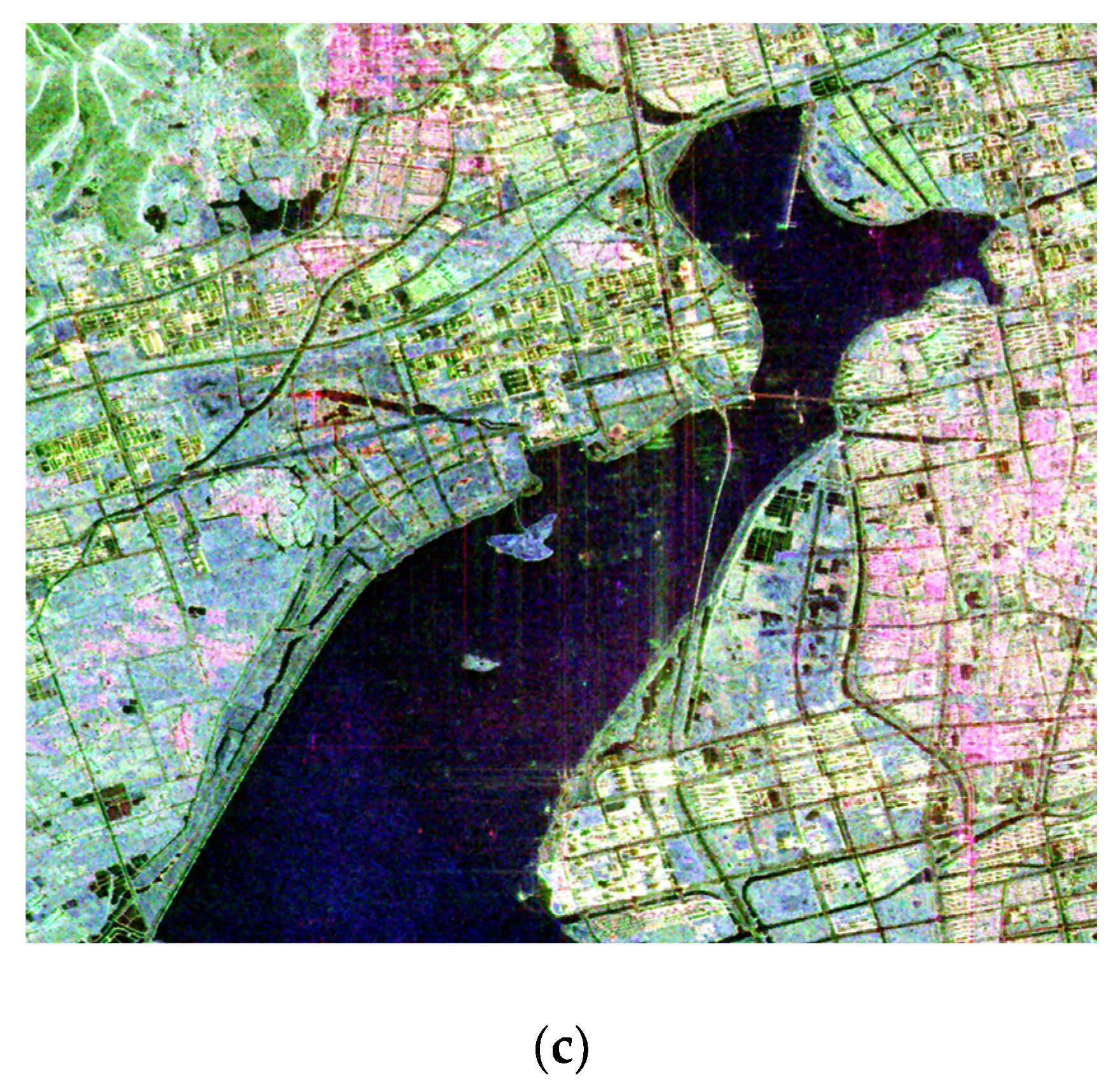
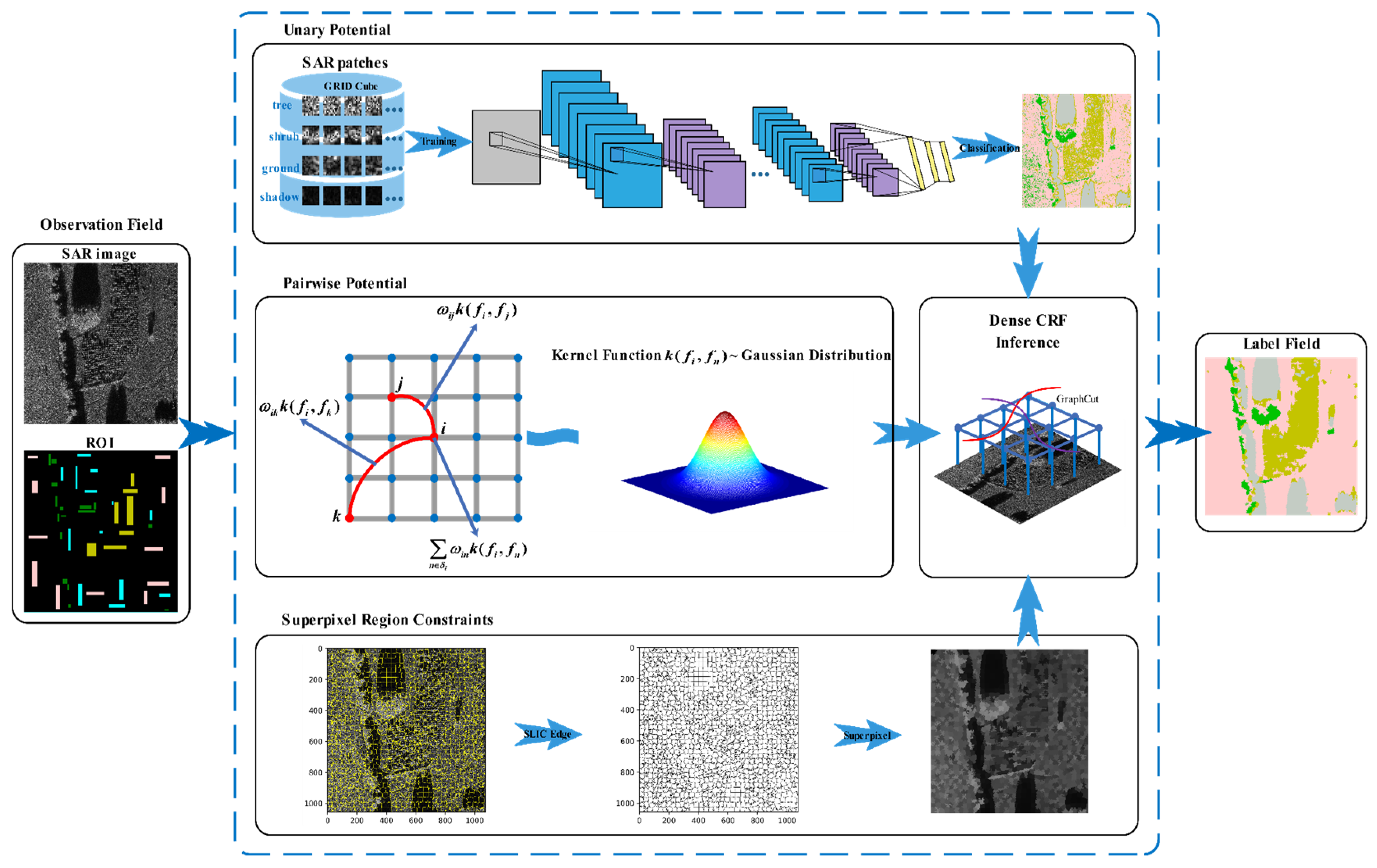
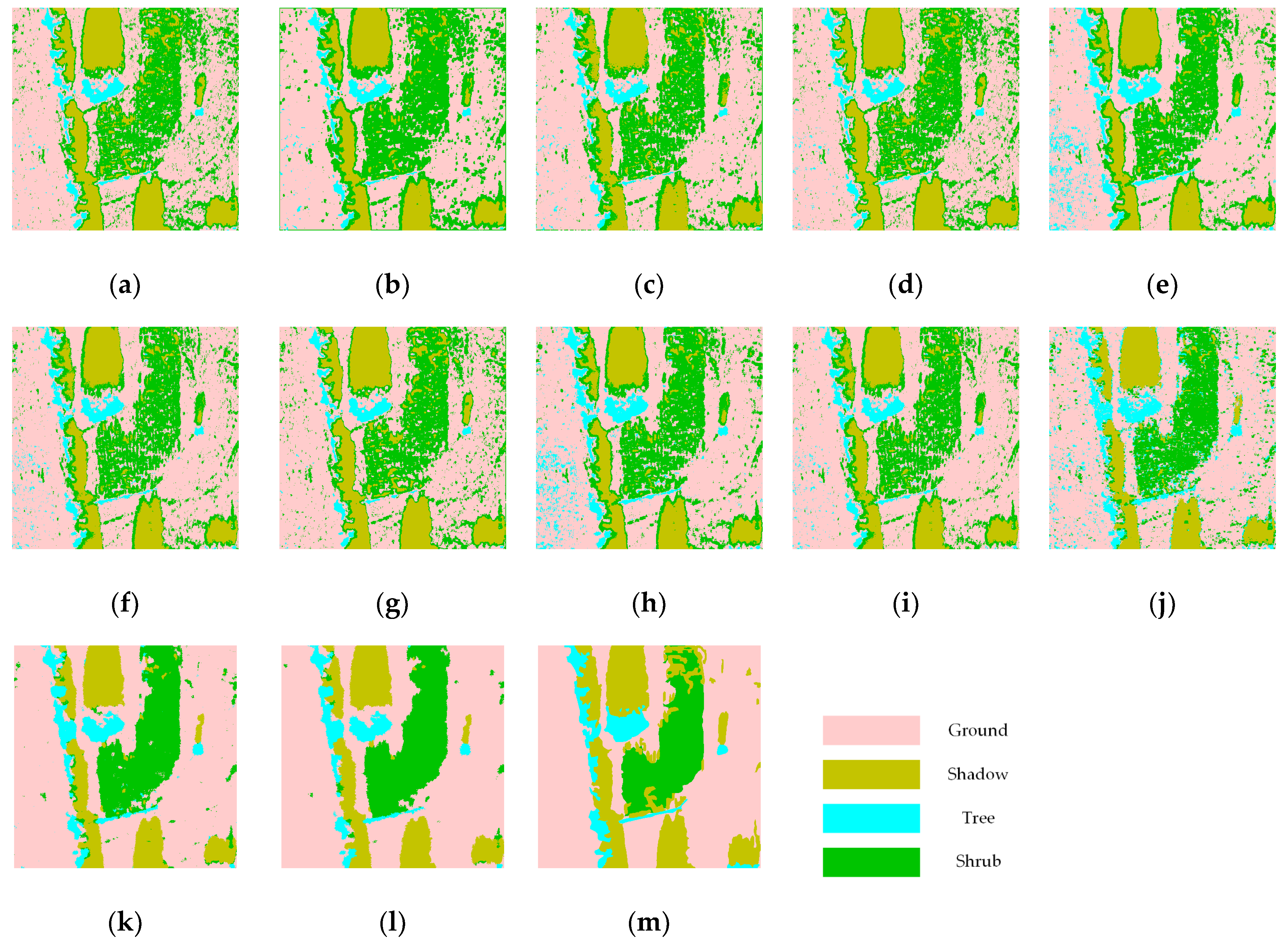
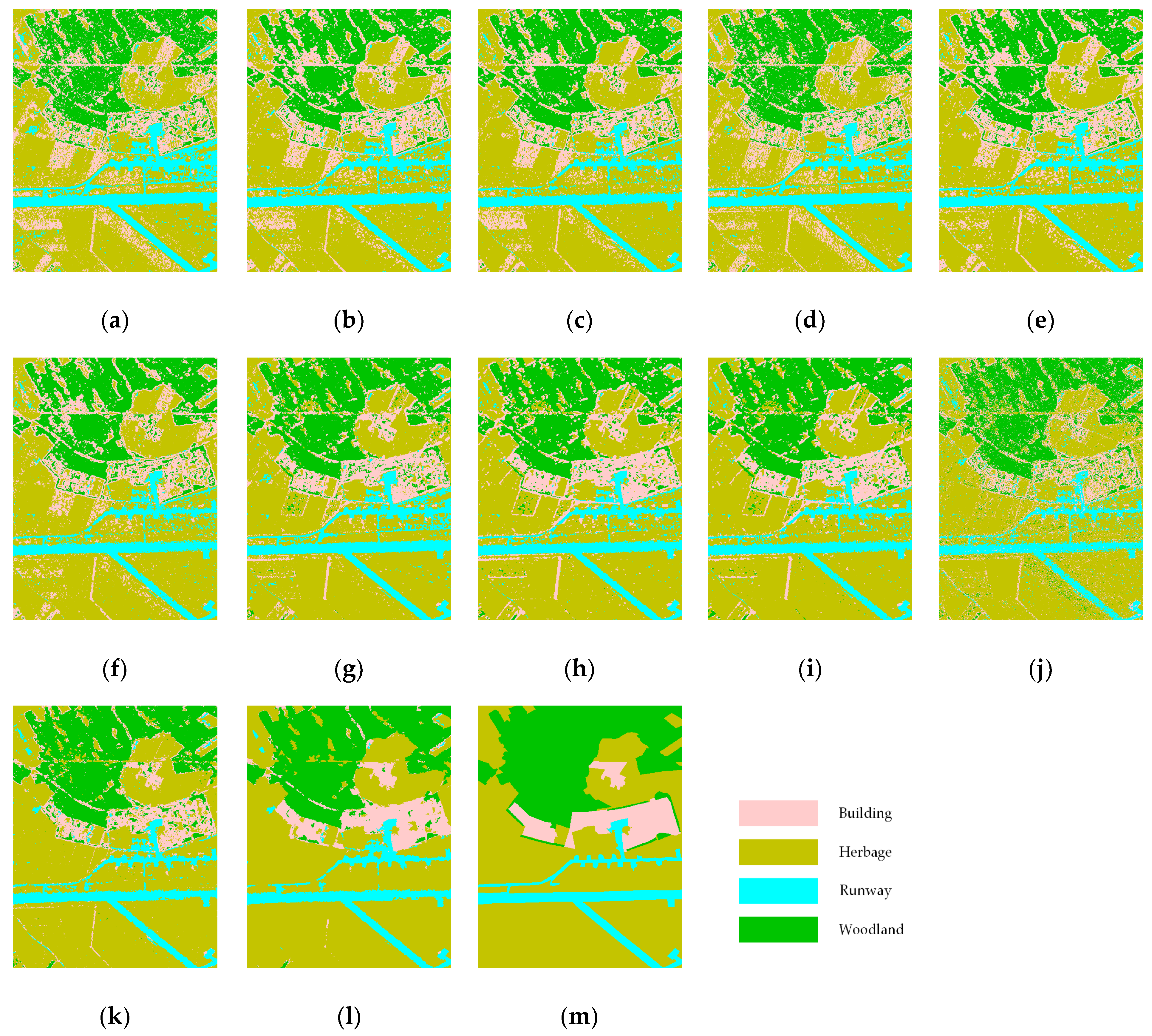

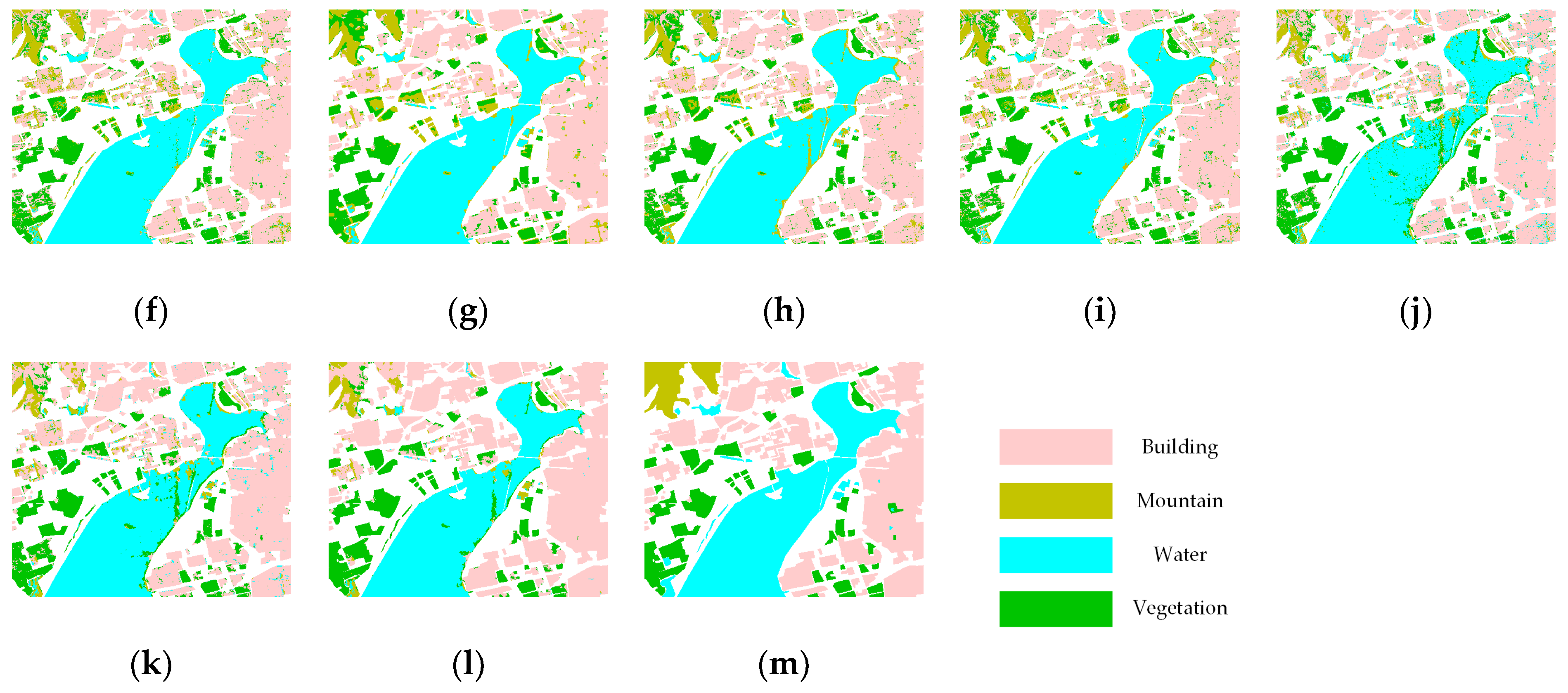

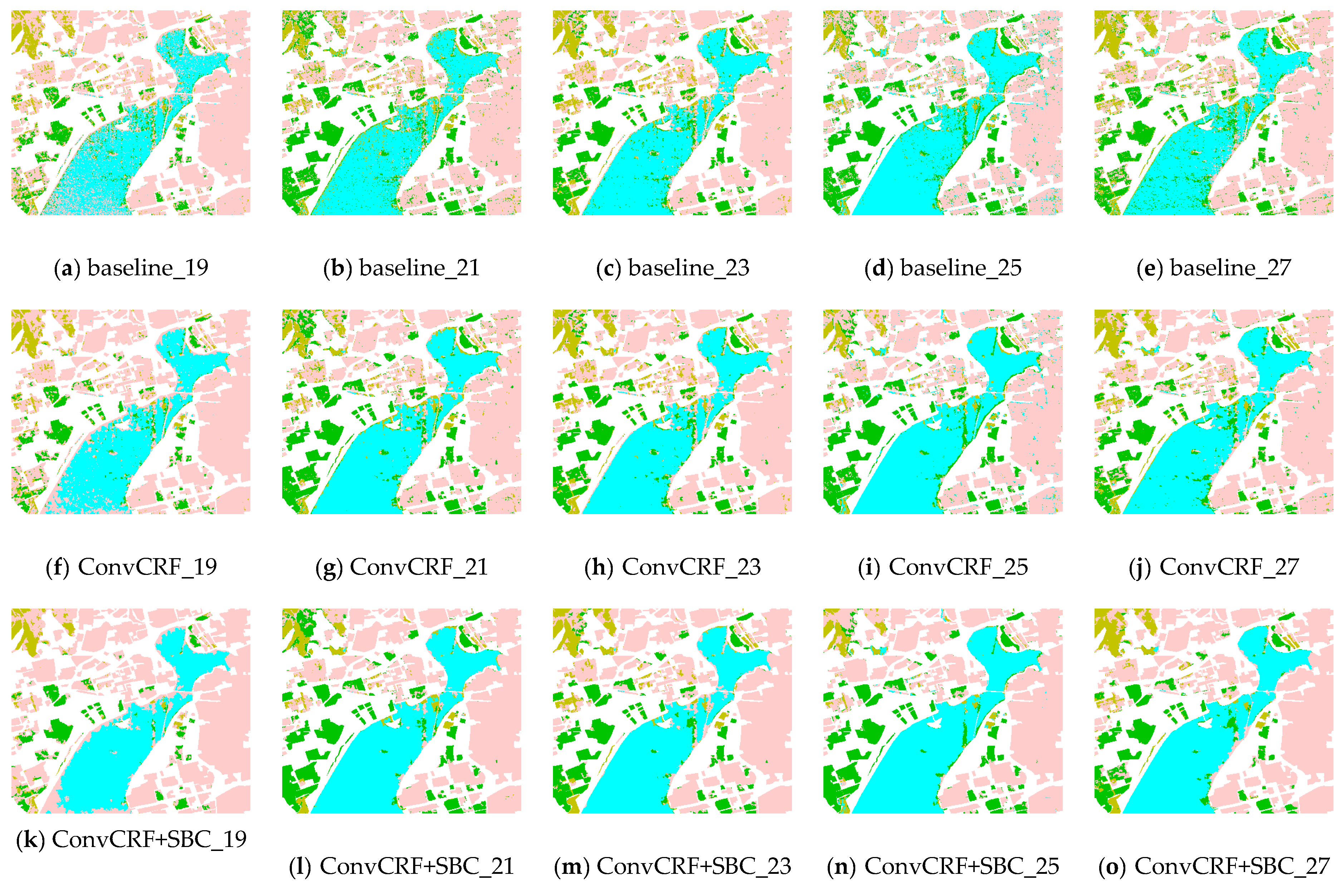

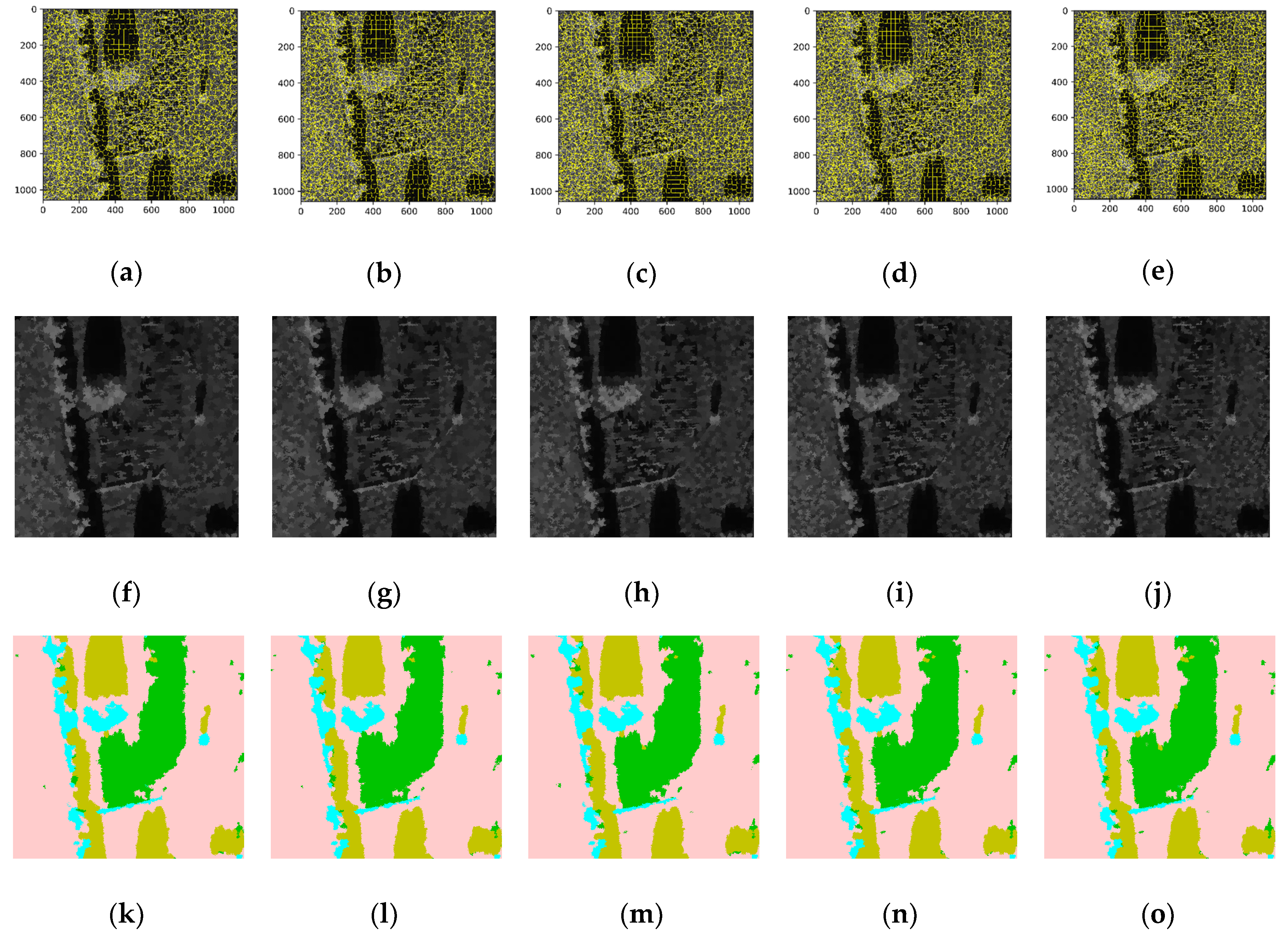
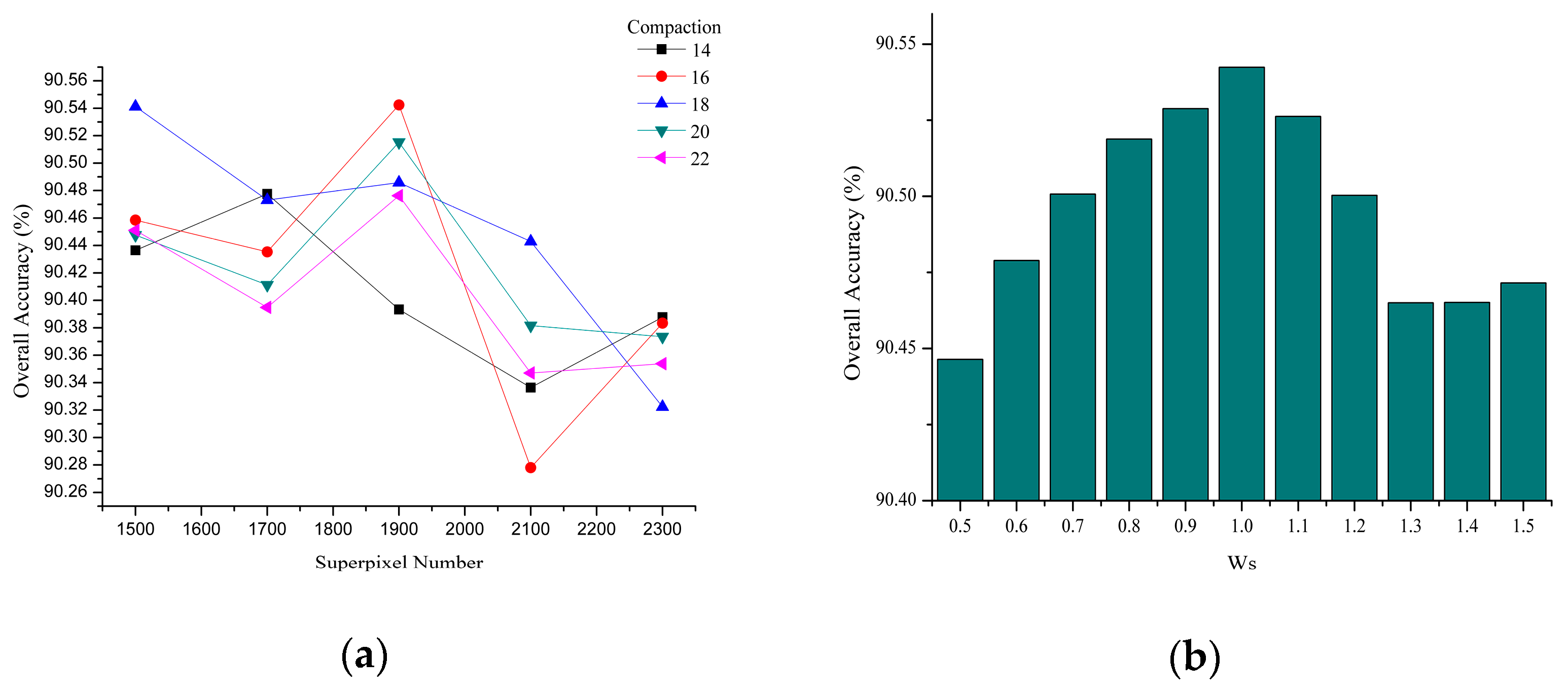

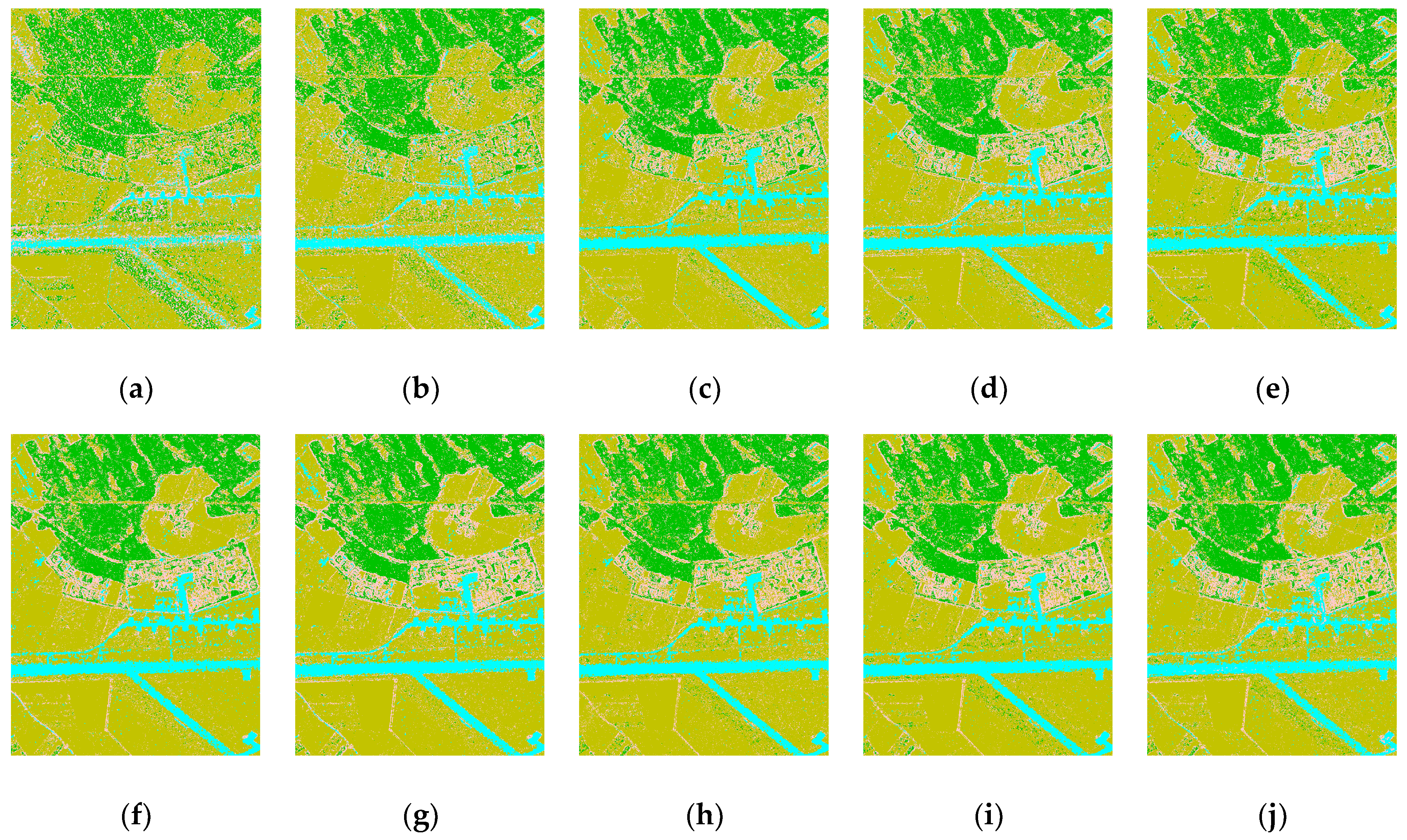
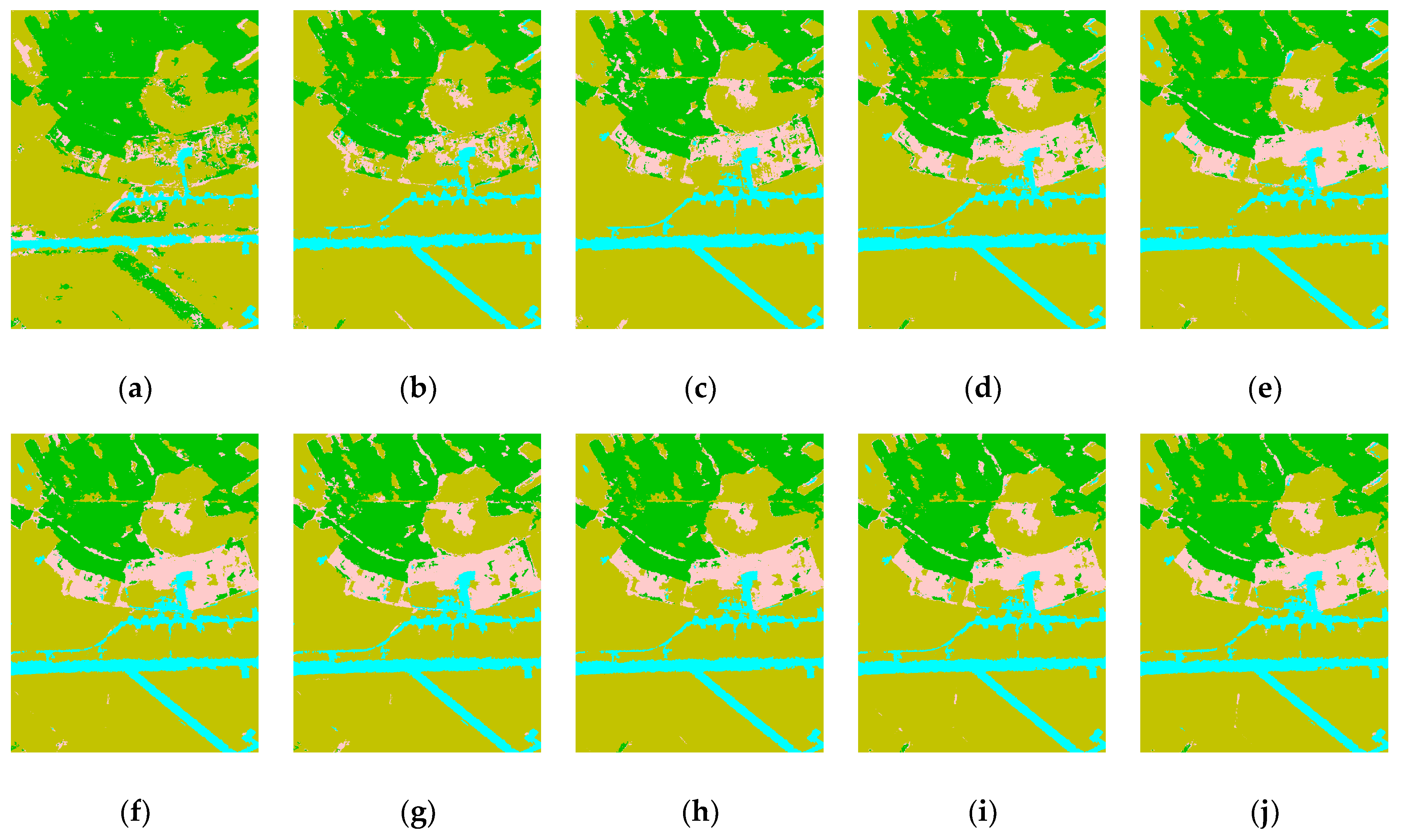
| Data 1 | Shrub | Ground | Shadow | Tree |
 |  |  |  | |
| Data 2 | Building | Woodland | Runway | Herbage |
 |  |  |  | |
| Data 3 | Building | Mountain | Water | Vegetation |
 |  |  |  |
| MSTAR | E-SAR | GF-3 | |||
|---|---|---|---|---|---|
| Ground | 10,000 | Building | 12,000 | Building | 15,000 |
| Shadow | 10,000 | Herbage | 12,000 | Mountain | 15,000 |
| Tree | 10,000 | Runway | 12,000 | Water | 15,000 |
| Shrub | 10,000 | Woodland | 12,000 | Vegetation | 15,000 |
| Algorithm | PA | UA | OA | Kappa | ||||||
|---|---|---|---|---|---|---|---|---|---|---|
| Ground | Shadow | Tree | Shrub | Ground | Shadow | Tree | Shrub | |||
| Gray + SVM | 82.80 ± 0.15 | 70.44 ± 0.26 | 48.91 ± 0.08 | 80.41 ± 0.44 | 90.69 ± 0.19 | 95.07 ± 0.37 | 94.53 ± 0.25 | 39.41 ± 0.31 | 77.71 ± 0.22 | 0.6344 ± 0.0009 |
| Gray + RF | 79.38 ± 0.43 | 61.52 ± 0.31 | 44.21 ± 0.28 | 88.22 ± 0.71 | 91.95 ± 0.28 | 98.87 ± 0.16 | 91.06 ± 0.72 | 35.70 ± 0.14 | 74.51 ± 0.38 | 0.5922 ± 0.0014 |
| Gray + GBDT | 86.74 ± 0.32 | 63.56 ± 0.24 | 44.09 ± 0.52 | 80.89 ± 0.09 | 90.97 ± 0.27 | 95.92 ± 0.11 | 88.92 ± 0.39 | 40.52 ± 0.17 | 78.33 ± 0.29 | 0.6387 ± 0.0005 |
| Gray + Gabor + SVM | 83.28 ± 0.58 | 70.50 ± 0.27 | 50.38 ± 1.14 | 80.08 ± 0.35 | 90.68 ± 0.14 | 95.03 ± 0.52 | 91.25 ± 0.35 | 40.07 ± 0.95 | 78.06 ± 0.60 | 0.6392 ± 0.0042 |
| Gray + Gabor + RF | 87.18 ± 0.37 | 58.55 ± 0.55 | 65.15 ± 0.87 | 81.06 ± 0.51 | 91.58 ± 0.62 | 98.77 ± 0.18 | 63.68 ± 0.29 | 43.40 ± 0.61 | 78.85 ± 0.33 | 0.6497 ± 0.0028 |
| Gray + Gabor + GBDT | 89.32 ± 0.75 | 57.11 ± 0.27 | 54.67 ± 0.38 | 78.99 ± 0.66 | 89.44 ± 0.90 | 98.43 ± 0.58 | 81.90 ± 0.70 | 42.77 ± 0.37 | 78.88 ± 0.52 | 0.6419 ± 0.0035 |
| Gray + GLCM + SVM | 85.76 ± 0.41 | 73.48 ± 0.17 | 43.62 ± 0.83 | 81.77 ± 0.63 | 90.42 ± 0.66 | 96.34 ± 0.51 | 97.20 ± 0.33 | 43.52 ± 0.69 | 79.96 ± 0.09 | 0.6656 ± 0.0008 |
| Gray + GLCM + RF | 86.88 ± 0.22 | 58.63 ± 0.56 | 64.76 ± 0.55 | 80.81 ± 0.16 | 91.49 ± 0.08 | 98.75 ± 0.17 | 62.27 ± 0.57 | 43.25 ± 0.47 | 78.63 ± 0.25 | 0.6465 ± 0.0027 |
| Gray + GLCM + GBDT | 90.40 ± 0.19 | 57.71 ± 0.28 | 54.14 ± 0.19 | 78.27 ± 0.77 | 89.24 ± 0.28 | 98.30 ± 0.64 | 84.07 ± 0.58 | 43.90 ± 0.73 | 79.52 ± 0.62 | 0.6503 ± 0.0016 |
| Baseline CNN | 89.73 ± 0.27 | 64.50 ± 0.54 | 71.28 ± 0.88 | 83.79 ± 1.02 | 91.12 ± 0.73 | 99.21 ± 0.24 | 49.81 ± 0.69 | 58.44 ± 0.52 | 82.38 ± 0.82 | 0.7041 ± 0.0050 |
| ConvCRF | 97.66 ± 0.38 | 67.45 ± 0.65 | 73.69 ± 0.17 | 94.27 ± 0.52 | 92.30 ± 0.67 | 99.68 ± 0.15 | 83.78 ± 0.82 | 71.24 ± 0.36 | 89.23 ± 0.44 | 0.8120 ± 0.0047 |
| ConvCRF + SBC | 98.29 ± 0.59 | 69.31 ± 0.96 | 74.55 ± 0.74 | 95.21 ± 0.56 | 92.32 ± 1.00 | 98.85 ± 0.07 | 88.63 ± 0.68 | 74.84 ± 0.76 | 90.18 ± 0.37 | 0.8279 ± 0.0033 |
| Algorithm | PA | UA | OA | Kappa | ||||||
|---|---|---|---|---|---|---|---|---|---|---|
| Building | Herbage | Runway | Woodland | Building | Herbage | Runway | Woodland | |||
| Polar + SVM | 63.56 ± 0.09 | 72.28 ± 0.18 | 92.69 ± 0.06 | 71.83 ± 0.11 | 23.03 ± 0.37 | 94.14 ± 0.08 | 58.20 ± 0.30 | 91.29 ± 0.08 | 73.12 ± 0.16 | 0.5967 ± 0.0008 |
| Polar + RF | 69.80 ± 0.22 | 80.03 ± 0.14 | 91.54 ± 0.25 | 67.64 ± 0.09 | 25.84 ± 0.56 | 94.74 ± 0.33 | 69.24 ± 0.29 | 93.42 ± 0.17 | 76.79 ± 0.39 | 0.6421 ± 0.0015 |
| Polar + GBDT | 66.35 ± 0.08 | 81.86 ± 0.26 | 87.80 ± 0.24 | 71.49 ± 0.11 | 26.65 ± 0.50 | 93.84 ± 0.19 | 74.40 ± 0.22 | 92.63 ± 0.05 | 78.29 ± 0.17 | 0.6600 ± 0.0013 |
| Polar + Gabor + SVM | 64.57 ± 0.36 | 76.82 ± 0.52 | 90.70 ± 0.40 | 74.42 ± 0.18 | 24.75 ± 0.28 | 94.14 ± 0.31 | 68.80 ± 0.16 | 91.54 ± 0.13 | 76.32 ± 0.44 | 0.6366 ± 0.0039 |
| Polar + Gabor + RF | 70.62 ± 0.12 | 80.96 ± 0.47 | 91.31 ± 0.21 | 67.82 ± 0.55 | 26.29 ± 0.42 | 95.19 ± 0.09 | 70.96 ± 0.27 | 93.27 ± 0.22 | 77.42 ± 0.57 | 0.6508 ± 0.0042 |
| Polar + Gabor + GBDT | 65.36 ± 0.67 | 83.97 ± 0.41 | 88.11 ± 0.19 | 71.21 ± 0.34 | 28.44 ± 0.81 | 94.00 ± 0.14 | 72.02 ± 0.52 | 92.31 ± 0.36 | 79.36 ± 0.41 | 0.6737 ± 0.0027 |
| Polar + GLCM + SVM | 76.04 ± 0.19 | 84.30 ± 0.35 | 90.64 ± 0.33 | 75.75 ± 0.26 | 38.59 ± 0.17 | 93.88 ± 0.22 | 66.09 ± 0.60 | 93.03 ± 0.09 | 81.84 ± 0.18 | 0.7113 ± 0.0010 |
| Polar + GLCM + RF | 80.83 ± 0.22 | 85.41 ± 0.41 | 88.94 ± 0.25 | 73.70 ± 0.16 | 37.45 ± 0.40 | 93.97 ± 0.18 | 73.65 ± 0.14 | 93.91 ± 0.20 | 82.17 ± 0.30 | 0.7158 ± 0.0022 |
| Polar + GLCM + GBDT | 76.66 ± 0.35 | 87.10 ± 0.21 | 87.08 ± 0.19 | 77.20 ± 0.17 | 41.00 ± 0.65 | 93.41 ± 0.20 | 74.35 ± 0.09 | 92.79 ± 0.17 | 83.58 ± 0.28 | 0.7346 ± 0.0014 |
| Baseline CNN | 58.55 ± 0.53 | 82.81 ± 0.14 | 78.21 ± 0.28 | 71.22 ± 0.33 | 29.17 ± 0.56 | 89.51 ± 0.19 | 67.80 ± 0.75 | 87.72 ± 0.43 | 77.36 ± 0.66 | 0.6357 ± 0.0035 |
| ConvCRF | 69.96 ± 0.33 | 92.67 ± 0.20 | 86.40 ± 0.13 | 81.24 ± 0.41 | 51.95 ± 0.39 | 92.60 ± 0.25 | 77.14 ± 0.33 | 94.54 ± 0.28 | 87.24 ± 0.36 | 0.7868 ± 0.0024 |
| ConvCRF + SBC | 86.10 ± 0.29 | 95.16 ± 0.31 | 87.87 ± 0.12 | 86.99 ± 0.30 | 69.82 ± 0.23 | 94.47 ± 0.17 | 82.28 ± 0.25 | 97.19 ± 0.13 | 91.63 ± 0.27 | 0.8593 ± 0.0021 |
| Algorithm | PA | UA | OA | Kappa | ||||||
|---|---|---|---|---|---|---|---|---|---|---|
| Building | Mountain | Water | Vegetation | Building | Mountain | Water | Vegetation | |||
| Polar + SVM | 87.50 ± 0.31 | 56.90 ± 0.60 | 97.46 ± 0.19 | 75.94 ± 0.44 | 97.09 ± 0.28 | 27.79 ± 0.81 | 99.73 ± 0.12 | 77.02 ± 0.29 | 87.87 ± 0.43 | 0.8179 ± 0.0051 |
| Polar + RF | 94.18 ± 0.26 | 40.63 ± 0.52 | 90.77 ± 0.37 | 81.17 ± 0.31 | 92.31 ± 0.26 | 28.37 ± 0.57 | 99.92 ± 0.03 | 80.61 ± 0.41 | 88.37 ± 0.41 | 0.8215 ± 0.0046 |
| Polar + GBDT | 89.24 ± 0.33 | 46.84 ± 0.69 | 94.25 ± 0.25 | 78.10 ± 0.29 | 91.21 ± 0.41 | 34.66 ± 0.66 | 99.61 ± 0.07 | 72.49 ± 0.35 | 87.29 ± 0.27 | 0.8056 ± 0.0032 |
| Polar + Gabor + SVM | 87.66 ± 0.44 | 56.99 ± 0.57 | 97.44 ± 0.41 | 75.83 ± 0.27 | 97.10 ± 0.22 | 27.94 ± 0.75 | 99.74 ± 0.11 | 77.04 ± 0.47 | 87.93 ± 0.35 | 0.8187 ± 0.0044 |
| Polar + Gabor + RF | 94.29 ± 0.25 | 40.34 ± 0.46 | 91.28 ± 0.15 | 80.53 ± 0.23 | 92.25 ± 0.16 | 29.52 ± 0.68 | 99.87 ± 0.06 | 79.65 ± 0.32 | 88.50 ± 0.38 | 0.8233 ± 0.0045 |
| Polar + Gabor + GBDT | 89.53 ± 0.13 | 47.43 ± 0.53 | 94.78 ± 0.26 | 77.02 ± 0.35 | 91.31 ± 0.22 | 35.35 ± 0.70 | 99.30 ± 0.10 | 73.17 ± 0.28 | 87.49 ± 0.50 | 0.8084 ± 0.0057 |
| Polar + GLCM + SVM | 92.65 ± 0.19 | 56.66 ± 0.41 | 96.03 ± 0.35 | 78.31 ± 0.46 | 98.36 ± 0.18 | 34.01 ± 0.53 | 99.89 ± 0.04 | 75.43 ± 0.49 | 90.01 ± 0.22 | 0.8485 ± 0.0024 |
| Polar + GLCM + RF | 93.48 ± 0.35 | 47.02 ± 0.31 | 91.16 ± 0.17 | 80.22 ± 0.25 | 93.82 ± 0.44 | 31.55 ± 0.37 | 99.87 ± 0.09 | 76.25 ± 0.36 | 88.40 ± 0.40 | 0.8229 ± 0.0039 |
| Polar + GLCM + GBDT | 89.93 ± 0.21 | 47.73 ± 0.37 | 93.43 ± 0.14 | 79.75 ± 0.36 | 91.62 ± 0.22 | 36.66 ± 0.43 | 99.46 ± 0.05 | 72.26 ± 0.24 | 87.58 ± 0.21 | 0.8101 ± 0.0028 |
| Baseline CNN | 90.07 ± 0.49 | 33.02 ± 0.61 | 83.64 ± 0.30 | 85.06 ± 0.45 | 88.11 ± 0.39 | 37.12 ± 0.85 | 94.16 ± 0.36 | 67.48 ± 0.57 | 84.10 ± 0.55 | 0.7555 ± 0.0062 |
| ConvCRF | 93.78 ± 0.21 | 33.57 ± 0.64 | 86.97 ± 0.27 | 87.74 ± 0.20 | 89.22 ± 0.13 | 40.53 ± 0.65 | 96.67 ± 0.15 | 75.73 ± 0.60 | 87.36 ± 0.47 | 0.8041 ± 0.0054 |
| ConvCRF + SBC | 97.99 ± 0.16 | 34.32 ± 0.37 | 90.45 ± 0.21 | 90.28 ± 0.34 | 89.80 ± 0.40 | 53.77 ± 0.57 | 99.68 ± 0.09 | 83.77 ± 0.25 | 90.91 ± 0.31 | 0.8574 ± 0.0028 |
Publisher’s Note: MDPI stays neutral with regard to jurisdictional claims in published maps and institutional affiliations. |
© 2021 by the authors. Licensee MDPI, Basel, Switzerland. This article is an open access article distributed under the terms and conditions of the Creative Commons Attribution (CC BY) license (http://creativecommons.org/licenses/by/4.0/).
Share and Cite
Sun, Z.; Liu, M.; Liu, P.; Li, J.; Yu, T.; Gu, X.; Yang, J.; Mi, X.; Cao, W.; Zhang, Z. SAR Image Classification Using Fully Connected Conditional Random Fields Combined with Deep Learning and Superpixel Boundary Constraint. Remote Sens. 2021, 13, 271. https://doi.org/10.3390/rs13020271
Sun Z, Liu M, Liu P, Li J, Yu T, Gu X, Yang J, Mi X, Cao W, Zhang Z. SAR Image Classification Using Fully Connected Conditional Random Fields Combined with Deep Learning and Superpixel Boundary Constraint. Remote Sensing. 2021; 13(2):271. https://doi.org/10.3390/rs13020271
Chicago/Turabian StyleSun, Zhensheng, Miao Liu, Peng Liu, Juan Li, Tao Yu, Xingfa Gu, Jian Yang, Xiaofei Mi, Weijia Cao, and Zhouwei Zhang. 2021. "SAR Image Classification Using Fully Connected Conditional Random Fields Combined with Deep Learning and Superpixel Boundary Constraint" Remote Sensing 13, no. 2: 271. https://doi.org/10.3390/rs13020271
APA StyleSun, Z., Liu, M., Liu, P., Li, J., Yu, T., Gu, X., Yang, J., Mi, X., Cao, W., & Zhang, Z. (2021). SAR Image Classification Using Fully Connected Conditional Random Fields Combined with Deep Learning and Superpixel Boundary Constraint. Remote Sensing, 13(2), 271. https://doi.org/10.3390/rs13020271








